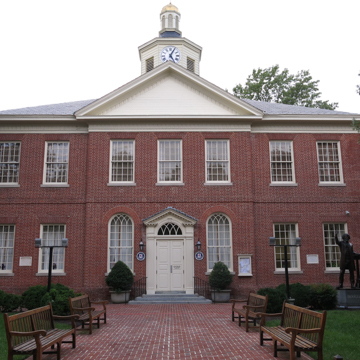The courthouse sits on a small landscaped square at the center of Easton, which was also the site of the first c. 1710 courthouse. That structure was replaced in 1794 with a five-bay, Georgian building. Expansion and renovation in 1898 added bays to either end, changed the entrance pavilion and windows, and added the current hipped roof and cupola. Additional changes over the years have expanded and altered the courthouse, particularly the 1958 additions to the rear and sides. Indicative of Maryland’s split loyalties during the Civil War and ongoing racial divisions, a monument of a Confederate soldier was erected on the courthouse grounds in 1916; the county council approved a resolution in September 2021 to move the Talbot Boys statue from public land to a privately owned park in Virginia. A statue of famed abolitionist Frederick Douglass, born and enslaved in Talbot County, has stood prominently in front of the courthouse since 2011.
You are here
TALBOT COUNTY COURTHOUSE
If SAH Archipedia has been useful to you, please consider supporting it.
SAH Archipedia tells the story of the United States through its buildings, landscapes, and cities. This freely available resource empowers the public with authoritative knowledge that deepens their understanding and appreciation of the built environment. But the Society of Architectural Historians, which created SAH Archipedia with University of Virginia Press, needs your support to maintain the high-caliber research, writing, photography, cartography, editing, design, and programming that make SAH Archipedia a trusted online resource available to all who value the history of place, heritage tourism, and learning.















